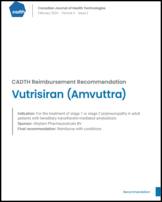|
Neurologic impairment
|
|---|
| Percent of patients with PND score: 1. “improvement” 2. “no change” 3. “worsened” Follow-up: 18 months | 199 (1 single-arm study with external control group) | NR | 1. | || || || | 2. | || || || | 3. | || || || | | 1. | || || || | 2. | || || || | 3. | || || || | | 1. | || || || | 2. | || || || | 3. | || || || | | Lowa,c,f,g | Vutrisiran may result in more patients with a PND score of “improvement” and “no change,” and fewer patients with a score of “worsened” when compared with placebo. There is some uncertainty about the clinical importance of the estimates. |
| mNIS+7: LS mean (SE) change from baseline (0 [best] to 304 [worst]) Follow-up: 18 months | 163 (1 single-arm study with external control group) | NR | 28.09 | –0.46 (1.60) | –28.55 (–34.00 to –23.10) | Lowa,c,f | Vutrisiran may result in a decrease (improvement) in mNIS+7 when compared to placebo. |
| COMPASS 31: change from baseline Follow-up: 18 months | NA | No data available. | No data available. | No data available. | No data available. | NA | There is no evidence for the effect of vutrisiran on neurologic impairment (as measured by the COMPASS 31) when compared to placebo. |
|
Functional impairment
|
|---|
| R-ODS score: LS mean (SE) change from baseline (48 [best] to 0 [worst]) Follow-up: 18 months | 167 (1 single-arm study with external control group) | NR | –9.9 | –1.5 (SE to 0.6) | 8.4 (6.5 to 10.4) | Lowa,b,f | Vutrisiran may result in a clinically important increase (improvement) in functional impairment measured by the R-ODS when compared to placebo. |
|
HRQoL
|
|---|
| Norfolk QoL-DN score: mean (SE) change from baseline (−4 [best] to 136 [worst]) Follow-up: 18 months | 165 (1 single-arm study with external control group) | NR | 19.8 | –1.2 (SE to 1.8) | –21.0 (–27.1 to –14.9) | Lowa,d,f | Vutrisiran may result in a clinically important decrease (improvement) in HRQoL measured with the Norfolk QoL-DN when compared to placebo. |
|
Serum TTR
|
|---|
| Serum TTR: percent change from baseline, median | NA | No data available. | No data available. | No data available. | No data available. | NA | There is no evidence for the effect of vutrisiran on serum TTR when compared with placebo. |
|
Harms
|
|---|
| Mortality Follow-up: 18 months | 199 (1 single-arm study with external control group) | NR |
| || || || |
|
| || || || || || || || || || || || |
|
| || || || || || || || || || || || || || || || |
| Very lowe,f,g,h | The evidence is very uncertain about the effects of vutrisiran on mortality vs. placebo. |
| Hospitalization Follow-up: 18 months | NA | No data available. | No data available. | No data available. | No data available. | NA | There is no evidence for the effect of vutrisiran on hospitalizations when compared with placebo. |
